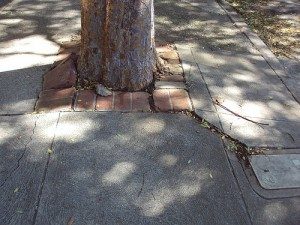We all enjoy the beauty of a street that is densely populated with trees. Not only does it add to the aesthetic quality of the area, but also has several health benefits as well, including that the production of fresh air. While the beauty and functionality of trees are truly extraordinary, they can sometimes act as an intrusion in our lives. For instance, some trees grow to on unimaginable sizes, causing not only visibility problems outside of structures but also proving to be a pain to maintain. One of the most common issues with trees that grow well beyond their initial size has to do with roots. As a tree expands outwards, its roots follow the same path.
 Now some of us may already know, nothing can stand in the way of tree roots. This obviously raises some concerns when looking at trees that line the sidewalk in residential areas. Although these trees do enhance the overall beauty of the area, the roots often lift the concrete slabs causing a safety hazard. In some areas, this problem has become so profound that each individual concrete slab is at least a few inches higher or lower than the one preceding it. The area can often be mistaken for one that was recently ravaged by an earthquake. When you think about the number of kids that can circulate a residential sidewalk, and even older adults whose vision might not be as well as they would like it, you obviously get a little concerned.
Now some of us may already know, nothing can stand in the way of tree roots. This obviously raises some concerns when looking at trees that line the sidewalk in residential areas. Although these trees do enhance the overall beauty of the area, the roots often lift the concrete slabs causing a safety hazard. In some areas, this problem has become so profound that each individual concrete slab is at least a few inches higher or lower than the one preceding it. The area can often be mistaken for one that was recently ravaged by an earthquake. When you think about the number of kids that can circulate a residential sidewalk, and even older adults whose vision might not be as well as they would like it, you obviously get a little concerned.
The question is, whose financial responsibility is it to try and tame the trees so that their roots stop protruding in such a way that it interferes with the alignment of the sidewalk? Well, this answer can vary, but there is little question that the only sensible way to go about this is to cut down the trees. Once the growth stops the roots can no longer cause further damage to the sidewalk. As we’ve discussed in the past, tree removal costs can depend on a variety of factors, but regardless it can be anywhere from moderately expensive to a very expensive. When we discuss the removal of tree roots, you know it’s going to a err on the expensive side. Fortunately, your city might be responsible for covering the costs, depending on where exactly the tree is located. You will have to talk to the appropriate officials to be sure. Otherwise, it might be in the responsibility of the homeowner to take care of the problem. This might seem unfair, but when you consider the injuries outgrown roots may cause, the investment might be well worth it.
It might be worth discussing the issue with your neighbors to see if you can pool resources together. It’s unlikely that at least several of your neighbors won’t be willing to lend some financial support. Considering the nature of the project, some tree removal contractors might even be more lenient when quoting you for the project. But remember, even with little discounts the costs can add up. The actual tree has to be cut down, the roots have to be removed, and finally, these materials needed to be disposed of. This often involves the use of a chipper, which costs money to run. Before the start any sort of work, you need to check with your city if you need a permit to perform the work. The process of obtaining a permit for tree removal can take some time, so the quicker you take action, the more likely the problem will be solved in an efficient manner.